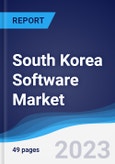Key Highlights
- The software market is defined as revenues generated from both: sales of, and subscriptions to, various software packages and offerings. The market includes both signed deals that remain under contract, and the annual revenues associated with new contracts signed, within a particular calendar year. This excludes sales opportunities for third-party services providers.
- With Korean SaaS firms developing SaaS products for the Korean market, the SaaS market in Korea is at an all-time high. The largest consumers of public cloud services in Korea are media, gaming, and digital native firms.
Scope
- Save time carrying out entry-level research by identifying the size, growth, major segments, and leading players in the software market in South Korea
- Use the Five Forces analysis to determine the competitive intensity and therefore attractiveness of the software market in South Korea
- Leading company profiles reveal details of key software market players’ global operations and financial performance
- Add weight to presentations and pitches by understanding the future growth prospects of the South Korea software market with five year forecasts
Reasons to Buy
- What was the size of the South Korea software market by value in 2022?
- What will be the size of the South Korea software market in 2027?
- What factors are affecting the strength of competition in the South Korea software market?
- How has the market performed over the last five years?
- What are the main segments that make up South Korea's software market?
Table of Contents
Companies Mentioned (Partial List)
A selection of companies mentioned in this report includes, but is not limited to:
- Microsoft Corporation
- International Business Machines Corporation
- Oracle Corporation
- Sony Corporation








